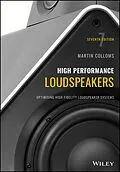Provides a technology overview of what goes into a high performance loudspeaker and covers all the latest advances in the field
The design of high performance loudspeakers requires a mix of developed skills in electroacoustics, high fidelity sound reproduction and subjective evaluation. Taking a designer's view of the subject, this new edition of High Performance Loudspeakers, Seventh Edition provides a comprehensive, timely and practical knowledge base to aid the design of superior loudspeaker systems fit for purpose. It is updated throughout with the latest progress in research and technology, synthesis and analysis, digital signal processing incorporated products, automated production test systems and wireless compact designs.
This Seventh Edition of the highly successful guide to the design and specifications of high quality loudspeakers and loudspeaker systems addresses the issue of where higher performance and sound quality is required and shows how the numerous considerations -- including application, target price, size, aspiration and particular market -- lead to a complex mix of design and engineering decisions. The book has also been substantially revised to reflect the many changes in the technology of loudspeakers and includes two brand new chapters -- one covering ultra-compact systems and DSP integration, and the second providing details of a worked example of the loudspeaker systems design process.
* Offers a complete overview of the technology
* Thoroughly updated with new content to reflect the latest advances in the field while retaining the firm theoretical foundation of previous editions
* Presents a designer's point of view of the field, helping to equip both amateur enthusiasts and academically trained graduates with industry practice
* Covers all the newest developments in the field of high performance loudspeakers
* Offers a critical and objective approach to all subjects covered, rather than a simple spelling out of theory and facts
* Appeals to both amateur speaker builders as a source of ideas, and to professional speaker designers with an overview of competitive products and features
Acknowledged industry-wide as the definitive work on speaker design and analysis, High Performance Loudspeakers, Seventh Edition is essential reading for audio engineers, speaker designers, equipment designers and students of acoustic engineering, electronics and electro-acoustics. It will also prove invaluable to students of electronics, broadcasting and recording techniques, but will also be of interest to authors and journalists in audio, and not least, amateur loudspeaker builders and enthusiasts.
Autorentext
Martin Colloms is an independent electroacoustics engineer in the UK who has seen over 200 of his high fidelity audio and speaker designs put into mass production. Martin has worked as a loudspeaker criticpublishing over 1,500 high fidelity speaker reviewsand is the technical editor of HIFICRITIC.
Inhalt
Preface to the First Edition xix
Preface to the Fifth Edition xxi
Preface to the Sixth Edition xxiii
Preface to the Seventh Edition xxv
Acknowledgements xxvii
1 General Review 1
1.1 Early Loudspeakers 1
1.2 Audible Frequency Range and Wavelength 4
1.3 The BBC Contribution 12
1.4 Emerging Standards 13
1.5 Influence of Improved LowFrequency Analysis 17
1.6 Changes in UK Lifestyle are Affecting Domestic Audio Systems 22
1.7 HighEnd Stereo Audio 23
1.8 Sound Docks 23
1.9 Headphones 27
1.10 Advances in Pro Audio 27
2 Developments in Loudspeaker System Design 31
2.1 Developments in Loudspeaker System Design 31
2.2 Limits to Performance 37
2.3 The Stereo Illusion: '3D Sound' 38
2.4 Sensitivity and Impedance 40
2.5 Enclosures 41
2.6 Drive Units 44
2.7 The Room 47
3 Theoretical Aspects of Diaphragm Radiators 51
3.1 Radiation From Simple Sources 51
3.2 Electromechanics of a Hypothetical MovingCoil Loudspeaker 57
3.3 Radiated Pressure 67
3.4 Relating the TwoPort Model to LowFrequency Analogous Circuits 74
3.5 Higher Modes of the Loudspeaker Diaphragm 77
4 Transducers Diaphragms and Loudspeaker Technologies 87
4.1 Dome Radiators 87
4.2 Velocity of Sound In a Diaphragm 93
4.3 Compensation of Dome Characteristics 95
4.4 Cone Behaviour 95
4.5 Cone Parameters 96
4.6 Cone Shape 104
4.7 Motor Systems 112
4.8 MovingCoil Motor Linearity 115
4.9 Effect of Magnetic Field Strength Variation on Loudspeaker Pressure Response 119
4.10 Magnet Systems 120
4.11 Film Transducers, Magnetic and Electrostatic 126
4.12 Bending Radiators, DML, Distributed Mode and BMR: The Balanced Mode Radiator 144
5 LowFrequency System Analysis: Room Environments and 2 Half Space Radiation 157
5.1 General Considerations 157
5.2 Room Interaction, The Broader Picture 165
5.3 Optimum System Design for Low Subjective Colouration 167
5.4 LF System Analysis 181
5.5 ViewpointWhat Is an Optimal LowFrequency Q Factor for a System? 195
5.6 ClosedBox System 198
5.7 Reflex or Vented Enclosures 207
5.8 BandPass Designs and LF Equalization 224
5.9 Longevity, Reliability, Tolerances, Climate 237
5.10 TransmissionLine Enclosures 243
5.11 SubWoofers and Extended LowFrequency Design 249
6 Horn and Other Loading Variations 261
6.1 Introduction 261
6.2 Line Source Loudspeakers 269
6.3 The MovingCoil Spaced Dipole 275
6.4 BiPolar Speakers 276
7 MovingCoil DirectRadiator Drivers 279
7.1 MovingCoil Motor System 279
7.2 Low Frequencies, Bass Units 283
7.3 LF/MF Units 306
7.4 MF, MidFrequency Units 309
7.5 HighFrequency Units 317
7.6 FullRange Units 326
7.7 Dynamics and Engineering 333
8 Systems and Crossovers 339
8.1 Passive Loudspeaker System Design 342
8.2 'TwoandaHalfWay' System Design 348
8.3 The Crossover Network and Target Function 349
8.4 Crossover Component Considerations 380
8.5 General Design Considerations, Voicing and Balancing 392
8.6 The AmplifierLoudspeaker Interface 407
8.7 Active Loudspeakers 416
8.8 Current Drive 436
8.9 Digital Loudspeakers 440
8.1...
